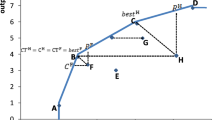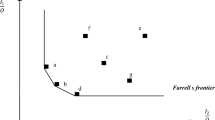Abstract
Traditional data envelopment analysis (DEA) models use all multiple inputs and outputs to estimate efficiency scores of decision-making units (DMUs). Each unit may consist of several subunits in cases such as manufacturing systems, and each subunit may produce both desirable and undesirable outputs. Providing information about the proportion of resources for each subunit could assist managers in making better decisions for increasing the efficiency of production systems. The current study proposes a new approach for resource allocation and efficiency estimation of production units by considering partial impacts among inputs and outputs in the DEA framework. A weak disposable technology is used in these evaluations, and an empirical application of the proposed approach for obtaining performance of home appliances production companies is provided for illustration purposes.



Similar content being viewed by others
Abbreviations
- \( j \in J, j = 1, \ldots ,n \) :
-
collection of DMUs
- \( m = 1, \ldots ,M \) :
-
set of good outputs
- \( s = 1, \ldots ,S \) :
-
set of bad outputs
- \( i = 1, \ldots ,I \) :
-
set of inputs
- \( k = 1, \ldots ,K \) :
-
number of bundles
- \( {\text{DMU}}_{o} \) :
-
DMU under evaluation
- \( v_{mj} \) :
-
mth good output of jth DMU
- \( w_{sj} \) :
-
sth bad output of jth DMU
- \( x_{ij} \) :
-
ith input of jth DMU
- \( v_{mo} \) :
-
mth good output of DMUo
- \( w_{so} \) :
-
sth bad output of DMUo
- \( x_{io} \) :
-
ith input of DMUo
- \( \mu_{m} \) :
-
weight for the rth good output
- \( \theta_{s} \) :
-
weight for the sth bad output
- \( \rho_{i} \) :
-
weight for the ith input
- \( \beta_{ik} \) :
-
split variable for \( x_{ij} \) in kth bundle
- \( I_{k} \) :
-
set of inputs in kth bundle
- \( T_{i} \) :
-
set of all k bundles that have i as a member
- \( R_{k} \left( {O_{G} , O_{B} } \right) \) :
-
kth bundle that has good or bad outputs
- \( \varepsilon \) :
-
non-Archimedean and very small number
- \( H_{kj} \) :
-
convex combination of k bundles’ efficiencies
- \( e_{agg} \) :
-
aggregate efficiency
- \( e_{ove} \) :
-
overall efficiency
References
Charnes A, Cooper W W and Rhodes E 1978 Measuring the efficiency of decision making units. Eur. J. Oper. Res. 2: 429–444
Wu J, An Q, Ali S and Liang L 2012 DEA based resource allocation considering environmental factors. Math. Comput. Model. 58: 1128–1137
Hailu A and Veeman T S 2001 Non-parametric productivity analysis with undesirable outputs: an application to the Canadian pulp and paper industry. Am. J. Agric. Econ. 83: 605–616
Chavas J P and Cox T L 1997 Production analysis: a non-parametric time series application to U.S. agriculture. Am. J. Agric. Econ. 48: 330–348
Kuosmanen T 2005 Weak disposability in non-parametric production analysis with undesirable outputs. Am. J. Agric. Econ. 87: 1077–1082
Zhou Y P, Poh K L and Ang B W 2008 Measuring environmental performance under different environmental DEA technologies. Energy Econ. 30: 1–14
Bain Y and Yang F 2010 Resource and environment efficiency analysis of provinces in China: a DEA approach based on Shannon’s entropy. Energy Policy 38: 1909–1917
Hosseinzadeh Lotfi F, Nematollahi N, Behzadi M H, Mirbolouki M and Z Moghaddasa 2012 Centralized resource allocation with stochastic data. J. Comput. Appl. Math. 236: 1783–1788
Mandal S K 2010 Do undesirable output and environmental regulation matter in energy efficiency analysis? Evidence from Indian cement industry. Energy Policy 38: 6076–6083
Dakpo K H, Jeanneaux P and Latruffe L 2015 Modelling pollution-generating technologies in performance benchmarking: recent developments, limits and future prospects in the nonparametric framework. Eur. J. Oper. Res. 250: 347–359
Yan H, Wei Q L and Hao G 2002 DEA models for resource reallocation and production input/output estimation. Eur. J. Oper. Res. 136: 19–31
Färe R and Grosskopf S 2004 Modeling undesirable factors in efficiency evaluation: comment. Eur. J. Oper. Res. 157: 242–245
Basso A and Peccati L A 2001 Optimal resource allocation with minimum activation levels and fixed costs. Eur. J. Oper. Res. 131: 536–549
Hadi-Vencheh A, Foroughi A A and Soleimani-damaneh M 2008 A DEA model for resource allocation. Econ. Model. 25: 983–993
Cecilio M M and Diego P 2006 On centralised resource allocation using DEA. Working Paper, Kent Business School, University of Kent, UK, pp. 146–154
Gomes E G and Lins M P E 2008 Modelling undesirable outputs with zero sum gains data envelopment analysis models. J. Oper. Res. Soc. 59: 616–623
Lin R C, Mustafa Y S and Pasupathy K S 2013 Multi-objective simulation optimization using data envelopment analysis and genetic algorithm: specific application to determining optimal resource levels in surgical services. Omega 41: 881–892
Korhonen P and Syrjanen M 2004 Resource allocation based on efficiency analysis. Manag. Sci. 50: 1134–1144
Yang T, Wang P and Li F 2018 Centralized resource allocation and target setting based on data envelopment analysis model. Math. Prob. Eng. 2018: 1–10
Amirteimoori A, Toloie-Eshlaghi A and Homayoonfar M 2014 Efficiency measurement in two-stage network structures considering undesirable outputs. Int. J. Ind. Math. 6: 65–71
Ming-Miin Y 2004 Measuring physical efficiency of domestic airports in Taiwan with undesirable outputs and environmental factors. J. Air Transp. Manag. 10: 295–303
Fukuyama H and Weber W L 2010 A slacks-based inefficiency measure for a two-stage system with bad outputs. Omega 38: 398–409
Wu J, Zhu Q, Ji X, Chu J and Liang L 2016 Two-stage network processes with shared resources and resources recovered from undesirable outputs. Eur. J. Oper. Res. 251: 182–197
Mogale D G, Kumar S K and Tiwari K M 2016 Two-stage Indian food grain supply chain network transportation-allocation model. In: Proceedings of the Manufacturing IFAC Conference, pp. 1767–1772
Mogale D G, Kumar S K and Tiwari M K 2018 An MINLP model to support the movement and storage decisions of the Indian food grain supply chain. Control Eng. Pract. 70: 98–113
Mogale D G, Dolgui A, Kandhway R, Kumar S K and Tiwari M K 2017 A multi-period inventory transportation model for tactical planning of food grain supply chain. Comput. Ind. Eng. 110: 379–394
Imanirad R, Cook W D and Zhu J 2013 Partial input to output impacts in DEA: production considerations and resource sharing among business subunits. Nav. Res. Logist. 60: 190–207
Yang H and Pollitt M 2010 The necessity of distinguishing weak and strong disposability among undesirable outputs in DEA: environmental performance of Chinese coal-fired power plants. Energy Policy 38: 4440–4444
Kuosmanen T and Podinovski V 2009 Weak disposability in nonparametric production analysis: reply to Färe and Grosskopf. Am. J. Agric. Econ. 91: 539–545
Kuosmanen T and Kazemi Matin R 2011 Duality of weakly disposable technology. Omega 39: 504–512
Charnes A and Cooper W W 1962 Programming with linear fractional functional. Nav. Res. Logist. 9: 181–185
Author information
Authors and Affiliations
Corresponding author
Appendix A
Appendix A
1.1 Creating the input, good output and bad output bundle
Following the notations used in Imanirad et al [27], input, good output and bad output bundles may be generated for each k=1,…,K, where \( I_{k} \) and \( R_{k} \left( {O_{G} , O_{B} } \right) \) represent a set of inputs, and good output and bad output, respectively. These bundles are generated so that \( R_{k} \)is from a mutually exclusive set and for each k, \( \left( {I_{k} , R_{k} \left( {O_{G} , O_{B} } \right)} \right)\quad k = 1, \ldots ,K \) is maximal based on the following definition.
Definition 1
An input, good output and bad output bundle \( \left( {I_{k} , R_{k} \left( {O_{G} , O_{B} } \right)} \right) \) is considered to be maximal if it possesses the following two properties:
-
1.
every good output v and every bad output w in \( R_{k} \left( {O_{G} , O_{B} } \right) \) are influenced by every input i in \( I_{k} \)and no other input outside of \( I_{k} \) may influence any good output v or any bad output w in \( R_{k} \left( {O_{G} , O_{B} } \right) \);
-
2.
there exists no output outside of \( R_{k} \left( {O_{G} , O_{B} } \right) \) whose input bundle is identical to that of \( R_{k} \left( {O_{G} , O_{B} } \right) \).
1.2 Algorithm 1 (creating maximal bundles)
-
Step 1: Define S to be an empty set.
-
Step 2: For each good output and bad output \( \left( {m,s} \right) \), derive \( I\left( {m,s} \right) \), the set of all inputs i that influence \( \left( {m,s} \right) \); transfer \( I\left( {m,s} \right) \) to S and set the bundle counter as\( k = 1 \).
-
Step 3: For each \( I\left( {m,s} \right) \) in S, compare it with every other \( I\left( {m^{\prime},s^{\prime}} \right) \) in S, and identify all \( I\left( {m^{\prime},s^{\prime}} \right) \) that have the same input elements as in\( I\left( {m,s} \right) \). If no such \( \left( {m^{\prime},s^{\prime}} \right) \) is identified, create bundle (\( I_{k} , R_{k} \left( {O_{G} , O_{B} } \right)) \) using \( I\left( {m,s} \right) \) and \( \left( {m,s} \right) \) so that \( \left( {I_{k} , R_{k} \left( {O_{G} , O_{B} } \right)} \right) = \left( {I\left( {m,s} \right),\left( {m,s} \right)} \right) \). Remove \( I\left( {m,s} \right) \)from S. Go to step 4. Otherwise, group good output and bad output \( \left( {m,s} \right) \) and all identified \( \left( {m^{\prime},s^{\prime}} \right) \) (having the same input sets) together to derive \( R_{k} \left( {O_{G} , O_{B} } \right) \) and create bundle \( \left( {I_{k} , R_{k} \left( {O_{G} , O_{B} } \right)} \right) \) using \( I\left( {m,s} \right) \) and \( R_{k} \left( {O_{G} , O_{B} } \right) \) so that \( \left( {I_{k} , R_{k} \left( {O_{G} , O_{B} } \right)} \right) = \left( {I\left( {m,s} \right),\left( {m,s} \right)} \right) \). Remove \( I\left( {m,s} \right) \) and all identified \( I\left( {m^{\prime},s^{\prime}} \right) \) from S. Go to step 4.
-
Step 4: If S is nonempty, set \( k = k + 1 \) and go to step 3. Otherwise, terminate having formed the set of all bundles.
Rights and permissions
About this article
Cite this article
Nemati, M., Matin, R.K. A data envelopment analysis approach for resource allocation with undesirable outputs: an application to home appliance production companies. Sādhanā 44, 11 (2019). https://doi.org/10.1007/s12046-018-0993-9
Received:
Revised:
Accepted:
Published:
DOI: https://doi.org/10.1007/s12046-018-0993-9




